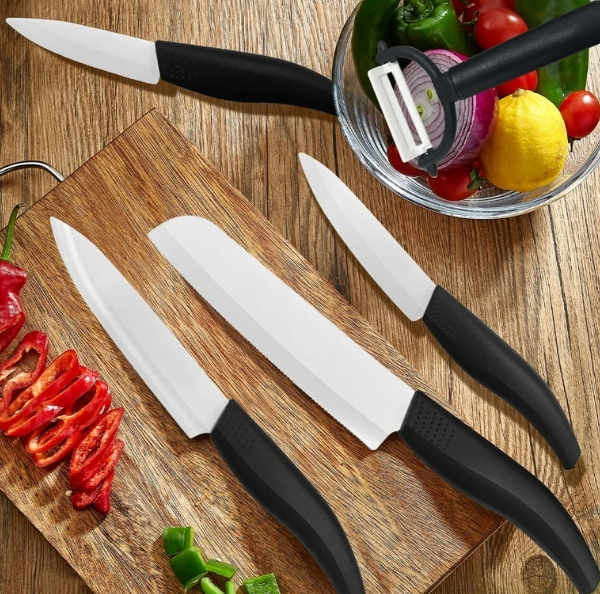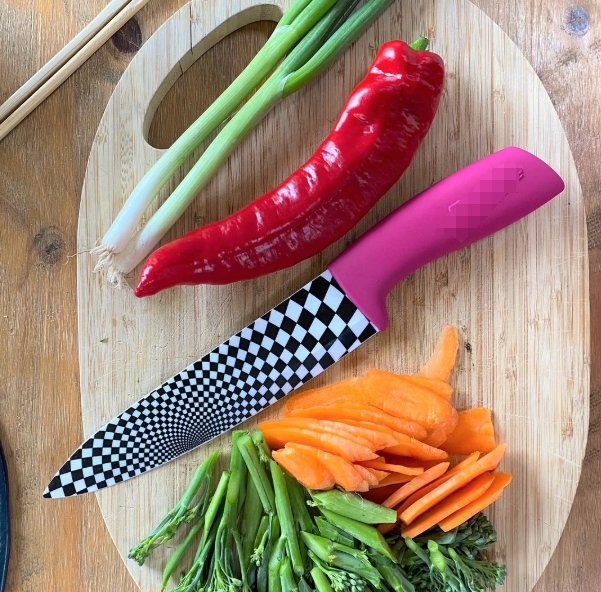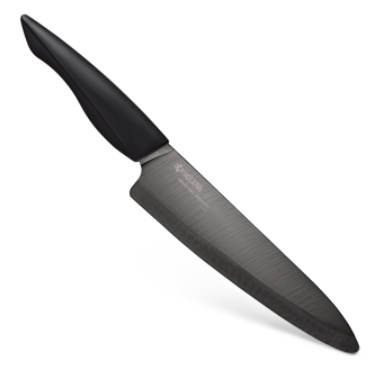

Views: 222 Author: Ella Publish Time: 2025-04-16 Origin: Site








Content Menu
● What Are Ceramic and Stainless Steel Knives?
● Sharpness and Edge Retention
● Environmental Impact and Sustainability
● FAQ
>> 1. Are ceramic knives better than stainless steel knives?
>> 2. Can ceramic knives be sharpened at home?
>> 3. Do ceramic knives break easily?
>> 4. Are stainless steel knives prone to rusting?
>> 5. What is the best knife for a home chef?
Choosing the perfect kitchen knife can transform your cooking experience. Two of the most popular options—ceramic and stainless steel knives—each offer unique benefits and drawbacks. This comprehensive guide explores their differences, advantages, and limitations to help you decide which is right for your kitchen.

Kitchen knives are the backbone of every culinary adventure. Whether you're a home cook or a professional chef, the right knife can make food preparation faster, safer, and more enjoyable. The ongoing debate between ceramic and stainless steel knives is fueled by their distinct characteristics. Understanding these differences is crucial for making an informed choice.
Ceramic knives are made from zirconium oxide, an advanced ceramic material known for its hardness and lightweight properties. They are typically white or black and are celebrated for their razor-sharp edges and resistance to rust and staining. Ceramic knives are chemically inert, meaning they won't react with acidic or alkaline foods, preserving the taste and appearance of your ingredients.
Stainless steel knives are crafted from an alloy of iron, carbon, and chromium. This combination provides durability, resistance to corrosion, and versatility. Stainless steel knives are the classic choice for both home and professional kitchens due to their robustness and ease of maintenance. They are available in a wide range of blade shapes and handle designs, catering to every culinary need.
Ceramic blades are renowned for their exceptional sharpness. The manufacturing process allows ceramic knives to be ground to a much finer edge than steel, making them ideal for precision slicing of fruits, vegetables, and boneless meats. Thanks to the hardness of zirconium oxide, ceramic knives retain their sharpness for a long time and rarely need sharpening. However, when they do become dull, sharpening is not as straightforward as with steel knives.
Stainless steel knives offer excellent cutting performance and can be honed to a sharp edge. However, they lose their edge faster than ceramic knives and require regular sharpening to maintain optimal performance. The advantage is that stainless steel knives can be easily sharpened at home using a variety of tools, ensuring they are always ready for use.
Ceramic knives are hard but brittle, making them prone to chipping or breaking if dropped or used on hard foods like bones or frozen items. They are best reserved for slicing softer foods and should not be used for prying, twisting, or chopping hard ingredients. Despite their fragility, ceramic knives are highly resistant to wear and will not corrode, rust, or discolor.
Stainless steel knives are highly durable and can withstand impact, bending, and heavy-duty tasks such as chopping bones or frozen foods. Their toughness makes them less likely to chip or break, even with rough handling. Steel knives are also more forgiving if you accidentally drop them or use them on harder surfaces.
Ceramic knives are low maintenance when it comes to cleaning, as they do not rust or stain. A simple rinse under running water is usually enough to keep them clean. However, sharpening ceramic knives is a challenge. They require diamond-coated tools or professional services, as traditional whetstones won't work. This can be inconvenient and costly over time.
Stainless steel knives require more frequent sharpening, but the process is straightforward and can be done at home using a whetstone, honing rod, or electric sharpener. Regular sharpening ensures that the knife remains effective and safe to use. While stainless steel knives can develop stains or rust if not properly cared for, most modern knives are highly resistant to corrosion.
Ceramic knives are much lighter than their steel counterparts, reducing hand fatigue during prolonged use. This makes them ideal for users who prefer a lightweight tool or have limited hand strength. However, some users find that the lack of weight can make the knife feel less balanced and harder to control, especially for tasks that require more force.
Stainless steel knives are heavier and often better balanced, providing a sense of control and stability. Many chefs prefer the heft of a steel knife, as it allows for more precise and confident cutting. The weight can also aid in chopping and slicing through tougher foods, making stainless steel knives more versatile in the kitchen.
Ceramic is non-porous, so ceramic knives don't absorb or transfer food odors, flavors, or bacteria. This makes them highly hygienic and easy to clean, reducing the risk of cross-contamination. Additionally, ceramic blades do not transfer metal ions to food, preserving the natural taste and color of ingredients.
Stainless steel knives, when properly cleaned, are also safe and hygienic for kitchen use. However, if not cleaned thoroughly, they can transfer flavors or odors between foods. Some high-carbon steel knives may react with acidic foods, potentially affecting the taste and appearance of ingredients, but most modern stainless steel knives are designed to resist such reactions.
Ceramic knives excel at slicing and dicing fruits, vegetables, and boneless meats. Their sharpness and precision make them ideal for delicate tasks, such as preparing sushi or finely chopping herbs. However, they are not suitable for chopping bones, frozen foods, or hard items, as this can damage the blade. The range of available ceramic knife styles is limited compared to steel knives, with most options being chef, santoku, and utility knives.
Stainless steel knives are the workhorses of the kitchen, suitable for all tasks, including chopping, slicing, dicing, mincing, and even heavy-duty jobs like cleaving and boning. They are available in a vast array of shapes and sizes, from paring knives to cleavers, making them the preferred choice for both home cooks and professional chefs who require versatility and reliability.

Ceramic knives often feature sleek, modern designs with bright white or black blades that stand out in any kitchen. Some manufacturers offer colorful handles or unique blade patterns, adding a touch of style to your culinary tools. The non-metallic appearance of ceramic knives can be appealing to those who appreciate minimalist or contemporary kitchen aesthetics.
Stainless steel knives are available in a wide range of designs, from traditional to modern. The shiny, metallic finish of a well-made steel knife exudes professionalism and durability. Many high-end knives feature ergonomic handles made from wood, resin, or composite materials, providing both comfort and visual appeal. The variety of styles ensures that there is a stainless steel knife to suit every taste and kitchen decor.
Ceramic knives are made from natural materials, primarily zirconium oxide, which is abundant in the earth's crust. The production process is energy-intensive, but the long lifespan of ceramic knives can offset some of the environmental impact. Because they rarely need sharpening and do not rust, ceramic knives can last for many years with proper care, reducing the need for frequent replacements.
Stainless steel knives are made from a combination of metals, some of which require significant energy to extract and process. However, many manufacturers now use recycled steel in their products, reducing the environmental footprint. Stainless steel knives are also highly durable and can last for decades with proper maintenance. When they do reach the end of their usable life, steel knives can be recycled, further minimizing their impact on the environment.
| Feature | Ceramic Knives | Stainless Steel Knives |
|---|---|---|
| Entry-Level Price | Generally affordable | Wide range, from budget to premium |
| High-End Models | Fewer options, expensive | Many luxury options |
| Maintenance Cost | Professional sharpening | Home sharpening possible |
| Longevity | Long edge retention, but may chip | Durable, can last decades with care |
Ceramic knives are often priced similarly to mid-range steel knives, but lack the extensive range of budget and premium models found in steel options. Stainless steel knives offer more choices for every budget, from inexpensive starter sets to high-end, handcrafted blades.
Both ceramic and stainless steel kitchen knives have their place in the modern kitchen. Ceramic knives excel at precision slicing, are lightweight, and require minimal maintenance, making them perfect for fruits, vegetables, and boneless meats. However, their brittleness and difficulty in sharpening limit their versatility.
Stainless steel knives, on the other hand, are the workhorses of the kitchen. They offer durability, versatility, and ease of maintenance, making them suitable for nearly all kitchen tasks. While they require more frequent sharpening and can transfer flavors if not cleaned properly, their resilience and range of styles make them the preferred choice for most cooks.
Choose ceramic knives if you value sharpness, lightness, and low maintenance for delicate tasks. Opt for stainless steel knives if you need durability, versatility, and ease of sharpening for a wide variety of kitchen jobs. Many chefs and home cooks find that owning both types covers all their culinary needs.

Ceramic knives are better for tasks requiring precision and sharpness, such as slicing fruits and vegetables. Stainless steel knives are more versatile and durable, making them better suited for heavy-duty kitchen tasks and general use.
No, ceramic knives cannot be sharpened with regular whetstones or honing rods. They require diamond-coated sharpeners or professional sharpening services.
Yes, ceramic knives are brittle and can chip or break if dropped or used on hard foods like bones or frozen meat.
Stainless steel knives are resistant to rust, especially when properly cared for. However, high-carbon steel knives can rust if not maintained, so regular cleaning and drying are recommended.
A high-quality stainless steel knife offers the most versatility and durability for a home chef. Ceramic knives are excellent for specific tasks like slicing delicate foods but are best used alongside steel knives for a complete kitchen setup.
[1] https://oishya.com/journal/ceramic-knives-vs-steel-knives-pros-cons/
[2] https://cutlery.kyocera.com/chefs-knives?orderby=10
[3] https://www.shopberghoff.com/products/2213384
[4] https://www.sliceproducts.com/pages/ceramic-vs-stainless-steel-knives
[5] https://dalstrong.com/blogs/news/ceramic-knives
[6] https://cutlery.kyocera.com/ceramic-knives
[7] https://dalstrong.com/blogs/news/ceramic-knife-vs-stainless-steel-knife
[8] https://asia.kyocera.com/products/kitchen/support/qa/
[9] https://kitchpulse.com/ceramic-knives-vs-steel-knives-pros-and-cons/
[10] https://faradayskitchenstore.com/collections/ceramic-knives
[11] /are-stainless-steel-or-ceramic-knives-better.html
[12] https://agarolifestyle.com/blogs/blogs-listing/stainless-steel-vs-ceramic-knife-set
[13] https://www.youtube.com/watch?v=yp8JYlNXP_Y
[14] https://www.myceramicknives.com/ceramic-vs-metal
[15] https://www.reddit.com/r/chefknives/comments/chqztw/what_are_the_pros_and_cons_of_ceramic_knives/
[16] https://cooking.stackexchange.com/questions/20900/should-i-buy-steel-or-ceramic-knives
[17] http://dalstrong.com/cdn/shop/articles/OS_85in_knife_stock4.01.jpg?v=1646032130&sa=X&ved=2ahUKEwjknaG2-NyMAxU0IbkGHU1vAFEQ_B16BAgIEAI
[18] https://www.istockphoto.com/photos/ceramic-knife
[19] https://www.swissknifeshop.com/collections/kyocera-ceramic-kitchen-knives-tools
[20] https://www.walmart.com/ip/Carote-12Pcs-Kitchen-Knife-Set-with-Blade-Guards-White-Granite-Ceramic-Knife-Stainless-Steel/5337672505
[21] https://stock.adobe.com/search/images?k=%22ceramic+knife%22
[22] https://www.etsy.com/market/ceramic_kitchen_knife
[23] https://www.shutterstock.com/search/steel-knife
[24] https://www.shutterstock.com/search/stainless-steel-knife
[25] https://mairico.com/product/mairico-ultra-sharp-premium-8-inch-stainless-steel-chef-knife/
[26] https://www.walmart.com/ip/Carote-14-Pcs-Knife-Set-with-Wooden-Block-Stainless-Steel-Knives-with-Ergonomic-Handle-Forged/5061159514
[27] https://www.youtube.com/watch?v=r4FAx1K1ATI
[28] https://www.youtube.com/watch?v=V-bvr_kblqc
[29] https://www.youtube.com/watch?v=QtWuXR8_EII
[30] https://www.youtube.com/watch?v=wfKxldapLPY
[31] https://www.youtube.com/watch?v=AVYjxT8_Aj4
[32] https://www.youtube.com/watch?v=N8PBIv1f0lY
[33] https://www.youtube.com/watch?v=dxCHlywiseo
[34] https://www.youtube.com/watch?v=yp8JYlNXP_Y
[35] https://www.youtube.com/watch?v=RDAyxALmlwg
[36] https://www.youtube.com/watch?v=FFEgg7OWsUk
[37] https://oishya.com/journal/ceramic-knives-vs-steel-knives-pros-cons/
[38] https://elementknife.com/pages/common-questions-about-kitchen-knives
[39] https://capecodcutlery.com/care-and-cleaning-of-knives/
[40] https://www.kitchenknifeforums.com/threads/why-so-much-love-for-ceramic-rods-vs-steel.35938/
[41] https://www.thekitchn.com/5-things-you-need-to-know-about-ceramic-knives-234886
[42] https://www.chefs-edge.com/blogs/knife-information/carbon-steel-v-stainless-steel-whats-better
[43] https://www.thearmorylife.com/forum/threads/ceramic-vs-steel-knives-is-one-better-or-are-they-just-different.19008/
[44] https://blog.isb-group.com/ceramic-blades-your-questions-answered
[45] https://www.knivesandtools.com/en/ct/steel-types-for-kitchen-knives.htm
[46] https://www.finedininglovers.com/explore/articles/cut-above-everything-you-need-know-about-ceramic-knives
[47] https://www.made-in-china.com/products-search/hot-china-products/Ceramic_Kitchen_Knife_Sets.html
[48] https://www.couteaux-morta.com/en/knives-collection/stainless-steel-chefs-knife/
[49] https://www.istockphoto.com/photos/stainless-steel-knife
[50] https://www.istockphoto.com/photos/steel-knife
[51] https://foldedsteel.com/blogs/learn-chef-knives/high-carbon-vs-stainless-time-to-cut-the-debate
[52] https://www.reddit.com/r/chefknives/comments/x83ke2/what_are_the_best_steels_for_chef_knives/
What's the Difference Between a Kitchen Knife and a Carving Knife?
What's the Difference Between a Paring Knife and a Kitchen Knife?
What's the Difference Between High Carbon and Stainless Steel Kitchen Knives?
What's the Difference Between Forged and Stamped Kitchen Knives?
What's the Difference Between a Chef's Knife and a Kitchen Knife?